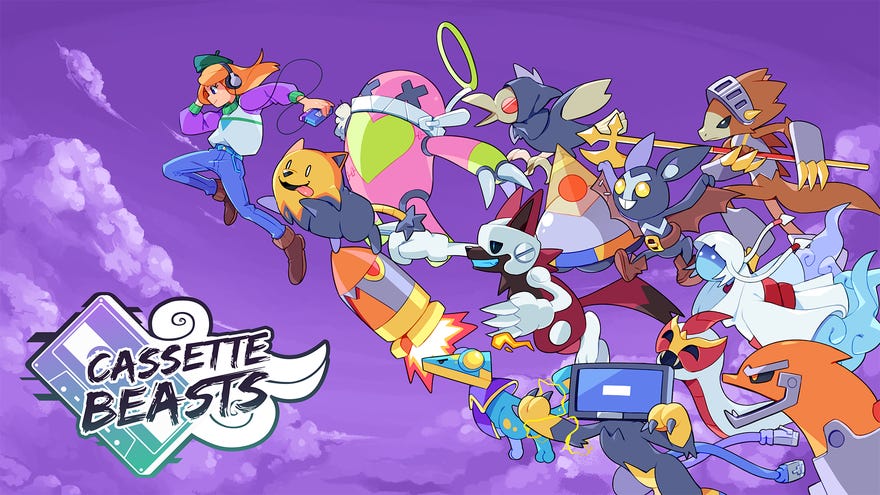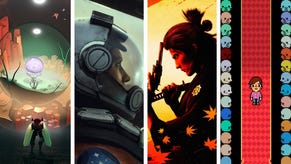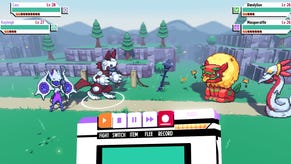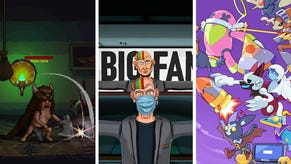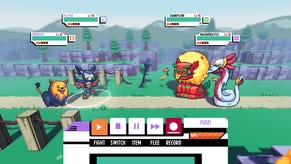Cassette Beasts review: dropping the mic on the Pokémon-like
Mew-sic to our ears
My name is Katharine and I'm a reformed Pokéaddict. I thought I'd get that out there right at the start, because you can't really talk about Cassette Beasts without talking a bit about Pokémon. Admittedly, the idea of an open world Pokémon-like might have lost some of its shine now that the actual Pokémon games have finally gone and done it themselves with last year's Scarlet and Violet releases, but Cassette Beasts, the debut game from UK micro team Bytten Studio, is banging a different kind of drum to Nintendo's primo monster catcher.
For starters, its gorgeous pixel art feels laser targeted at folks like me who grew up on the likes of Red and Blue back in the late 90s and early 00s. The kind of people who, and this is based solely on personal experience, have probably been wondering what an open world Pokémon game might look like ever since they first clapped eyes on the wonky backsides of their Game Boy Charmanders. Not that the concept of open world games was as fully formed as it today back in 1999, but you know what I mean. The chance to explore a world full of cool, magical creatures you could see in plain sight roaming out in the wild, not hidden by chuffing long grass, and the freedom to pursue exactly the kind of Poké career you saw being celebrated in the Pokémon anime, stepping back from being an all-time master champion to try your hand at being a breeder, a professor or a photographer.
And yes, Scarlet and Violet certainly tapped into a lot of these fantasies when they came out last year, or at least they did when they weren't running at ten frames a second, or wigging out under a mountain of bugs and hiccups. But even putting their technical woes aside for one minute, my biggest problem with Scarlet and Violet - and this is why I'm a reformed Poké person rather than a current one - is that, fundamentally, it's still Pokémon. The same old Pokémon we've been playing for the last two and a bit decades, with the same elemental combos, the same old schtick of catch, evolve and stick in a box, and the same 'this game is great if you're ten-years-old' energy. Pokémon is, and always will be, a fantastic game for ten-year-olds. That was the age I fell in love with it, and it has stuck steadfast to serving those ever-present ten-year-olds ever since. Just ask Ash Ketchum, who recently retired at the grand old age of ten after being in the business for 26 years.
Cassette Beasts, on the other hand, feels like more of a thinking person's Pokémon - the kind that caters to those lifelong Poké peeps who are now in their 30s (and have been wishing Pokémon would grow up alongside them ever since they first encountered it) much more effectively. It not only sands off a lot of Pokémon's rougher, niggling edges, but it also goes much deeper on its RPG elements, giving you multiple storylines to pursue at once, a party of companions to pick from (each of whom have their own story quests to explore), as well as gradually evolving relationship bonuses based on the depth of your friendship with them. It's very Persona, albeit without the constant worry of only having limited time to earn best pal status.
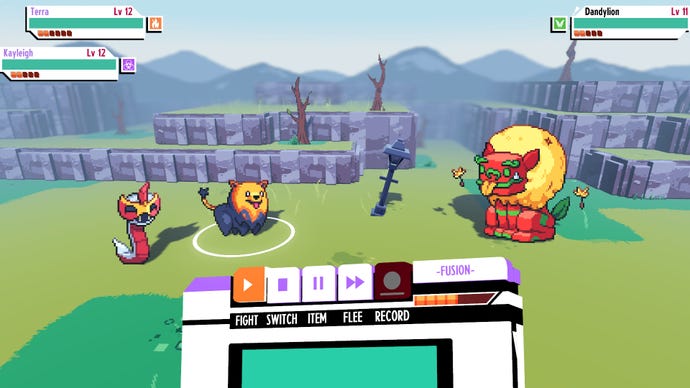


Cassette Beasts' masterstroke, though, is the way it uncouples levelling up from your individual monsters. Instead, it's just you, your human avatar, who levels up, providing a foundation of base stats which your monsters then sit on top of. Beasts can still become more powerful, evolve, and learn new moves as you gain experience, but the boost provided by your avatar gives you a lot more freedom to try out new ones you've just recorded without the threat of them getting instantly mullered in higher level areas. It levels the playing field, and provides an effective remedy for one of my biggest sticking points with Pokémon proper.
Cassette Beasts' masterstroke is the way it uncouples levelling up from your individual monsters.
It also applies a much more scientific eye to your monsters' types and elemental attacks. Fire isn't just not great against water, for example. It also creates a healing mist of steam for the receiving water monster. Hit a metal type with a poison attack, meanwhile, and they'll receive a whole coat of the stuff, allowing them to deal extra poisonous contact damage the next time they perform a melee attack. Air types, on the other hand, can 'uproot' plant types, disconnecting them (and any sneaky leech attacks they've got going) from the ground. Earth smothers fire. Metal and water conduct electricity. Plastic types can be 'melted' with fire and release noxious fumes, turning them into temporary poison types.

The list goes on, and it's genuinely exciting to see something new crop up every couple of battles. I was still discovering new effects ten, twelve hours into the game as I played new monster types, and it always felt like I was learning something new, especially when you've always got two monsters in play (one for you, and one for your accompanying NPC companion) instead of one. Best of all, Cassette Beasts rarely takes you by surprise, as it telegraphs would-be effects when you're choosing your intended target. Sure, it can take some time to figure out what its bevy of warning icons mean occasionally, but even accidentally shooting yourself in the foot and giving your enemy a temporary advantage rarely spells the end for you as a player. Indeed, its turn-based battles rely less on exploiting 'super effective' elemental loopholes (though they do still hurt like the devil when they crop up), and more on clever use of attritional effects and buffs - and you'll need to manage your slowly replenishing pool of action points in order to do it.
This is particularly evident in its multitude of boss battle types. The main plot sees you tracking down screen-hogging 'Archangels' in abandoned underground train stations to try and find a way home from the strange island of New Wirral, but there are also Ranger battles to pursue (this game's version of gym leaders), and 'Rogue Fusion' challenges, the latter of which see you face off against two monsters that have been merged into one. These larger than life fights help keep Cassette Beasts' regular battles from getting too stale, and you can, of course, always fuse your own active beasts together for added spice when you've built up your fusion bar. Given you can fuse any two beasts together in this game, Cassette Beasts does a pretty impressive job with the final result, creating a weird and wonderful array of sprites that not only capture the essence of both monsters you've chucked together, but who also draw from each mon's respective movepool.
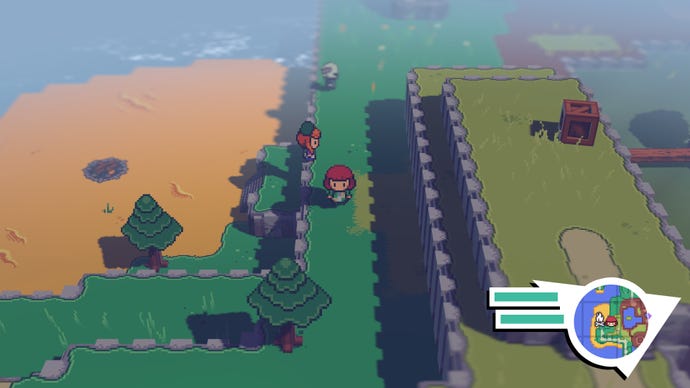

Cassette Beasts is wonderfully carefree in the way it approaches said monster attacks, too. Beasts will gradually learn new moves over time, but you can also remove and add new ones at any time by peeling off and reapplying 'stickers' to their respective tapes (monsters are 'recorded' rather than 'captured' here, hence the name Cassette Beasts). It's the kind of freedom I've wished Pokémon's TMs would have for years, and it really lets you edit and customise your squad to your liking. Not all monsters are compatible with all stickers, mind, and you'll still need to find some of those rarer, more powerful moves out in the world, too (or draft them in from other monsters you've recorded). But the pain, frustration and choice paralysis of Pokémon's four move limit is blissfully absent.
It's the kind of freedom I've wished Pokémon's TMs would have for years, and it really lets you edit and customise your squad to your liking.
What's more, since you yourself transform into these monsters rather than sending them out to do your bidding, recording certain types of monsters also gives your avatar new abilities too, such as swimming, gliding, dashing and even rolling up into a spiky pumpkin ball to climb walls. In lesser hands, fixing these Metroid-esque (or in Poké-parlance, HM-like) abilities to individual monsters might have spelled disaster and confusion in an open-ended game like this, but Bytten Studio have cleverly headed off most concerns about 'what the heck do I do next?' with its gentle rumour system. Fellow townsfolk in your base camp of Harbourtown are more than happy to offer up titbits of info and suggestions for where you should head next if you find yourself at the end of a questline or stumped by a particular environmental roadblock, and as such I always had something to investigate regardless of where I was in the story.
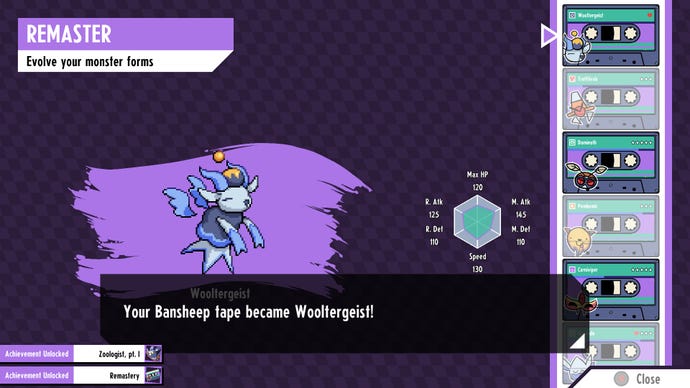
Those HM, Metroid-like abilities come a steady pace, too, making it feel like you're constantly pushing into this mysterious world without it deliberately holding stuff back from you. Indeed, bar a few obvious locked gates (for which there are always usually handy switches hidden nearby), the world of New Wirral is tantalisingly free to noodle around in and explore at your own pace. There was a stretch where I did feel a little over-levelled at one point - albeit done naturally through other trainer-style battles and my own efforts to record monsters for my bestiary rather than outright grinding - but when I hit level 40-odd, the difficulty snapped right back into place, suddenly catching up (and maybe even getting a little ahead) to where I was. For the most part, though, its pacing is all fairly seamless.
The fact this is all the work of mostly two developers also just blows my mind a tiny bit, too. I don't think it will convert those who have never enjoyed a Pokémon game before, and I can also see its in-depth elemental system being a bit too much like a GSCE chemistry lesson to capture the attention of those Pikachu-loving ten-year-olds. But for those who have felt increasingly like the Pokésphere just doesn't cut it for them anymore, there's definitely a lot to like and admire here. Pokémon will always likely be the dominant force in the monster-catching genre, but Cassette Beasts is a smart, evolutionary offshoot from the Game Freak family tree that I hope has a long and happy life ahead of it.
This review is based on a retail build of the game provided by the publisher Raw Fury.
